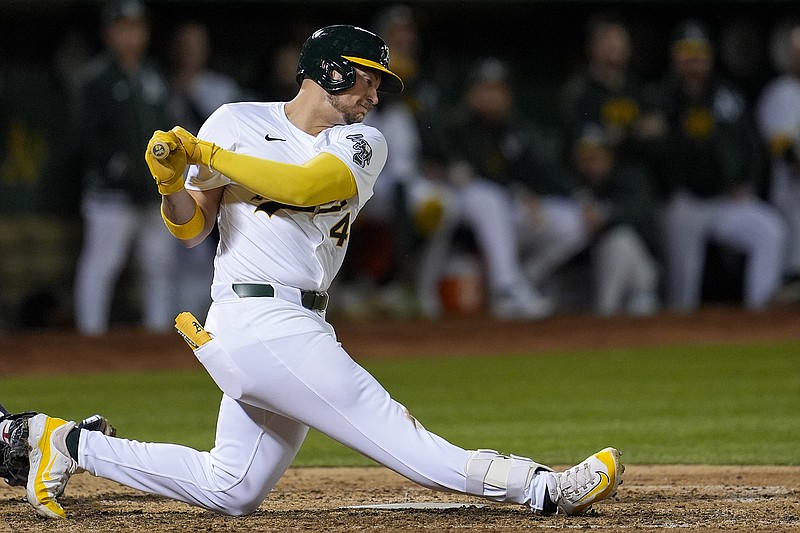NEW YORK — The batting average across Major League Baseball dropped seven percentage points to .242 in the first two weeks of the 2024 season, while the average time of a nine-inning game rose two minutes to 2 hours, 39 minutes in the second season with the pitch clock in action.
MLB officials implemented restrictions on defensive shifts last year, when the batting average rose to .249 in the first 14 days from .230 the comparable period in 2022 and .235 in 2021. Last year's final average of .248 was up from .243 in 2022 and .244 in 2021; it had been in the .250s for most of the decade in the 2010s and the .260s in the early 2000s.
The average rises during the course of the season as the weather warms.
"No question, it's getting harder to hit,'" Kansas City Royals outfielder Hunter Renfroe said Friday. "I think these pitchers are getting better and better every single year. You've got younger and younger arms coming up that people have less and less history against. And I think it's one those things where it's going to continue to evolve, and the hitters are going to evolve, as well.
"But to this point, yeah, it's a lot harder to hit now than it ever has been, there's no question about it."
The average four-seam fastball velocity is 94.2 mph this season, up from a record 94.0 mph last year. It was 93.2 mph when Renfroe was a rookie in 2017. The total of 100 mph or more pitches rose from 1,107 in 2017 to 3,880 last year.
Right-handed batting average fell to .240 from .254 in the opening two weeks, while left-handed batting average rose two percentage points to .244.
Home runs per game declined to 2.0 from 2.3.
"At the beginning of the season, all the pitchers are healthy, they're not tired yet. I think it'll trend in our direction a little bit as the season goes on," said the Colorado Rockies' Charlie Blackmon, the 2017 National League batting champion.
"But I do think there's more specialization, partially due to the technology. Guys who do something well now know exactly what that is and where to exploit it, but that's almost only a pitching advantage. You can't tell me my metrics or the spin rate on my swing and tell me how to hit better, right?"
Stolen bases remained at an average of 2.4 per game, though the success rate declined slightly to 78.6% from 81.2%. Steals rose sharply last year to 3,503 steals from 2,486, for the most since 1987. Last season's increase followed the introduction of 18-inch square bases, up from 15 inches, which reduced the distance between first and second, and second and third, by 4 1/2 inches.
The average time of nine-inning games was 2:37 in the first two weeks of the last season, when a clock was introduced over the objection of the players' association, set at 15 seconds with the bases empty and 20 seconds with runners on base. MLB lowered the time with runners on base to 18 seconds for this season, a change union head Tony Clark blames for a series of pitcher injuries.
Last year's final average of 2:40 was MLB's lowest since 1985 and a 24-minute decrease from 2022.
MLB estimates the change this year saved three minutes and the increase is largely attributable to more players using timeouts. The average increased gradually last season from 2:37 in April to 2:41 in July and August and 2:44 in September.
"There's probably about a timeout every single at-bat now," Royals first baseman Vinnie Pasquantino said. "It definitely feels like guys are winding the clock down more than they were last year. That could be one more year of experience with it, just being more comfortable with what they're doing. But, yeah, I just think the weather probably has effect in that, too."
Tampa Bay Rays pitcher Ryan Pepiot said his team held a meeting to discuss timeout management. The Rays discussed when he should "step off and give myself a couple extra seconds to reset, get back in zone and just kind of utilize the time that is given."
Pitch clock violations dropped to an average of 0.34 per games from 0.84 in the first two weeks. Pitcher and catcher violations fell to 0.26 from 0.61 and batter violations dropped to 0.09 from 0.23. The San Diego Padres had the most violations with eight, and the Arizona Diamondbacks, Rays, Rockies and Royals tied for the fewest with one each.
